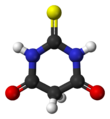Chemistry:Thiobarbituric acid
From HandWiki
| |||
| Names | |||
|---|---|---|---|
| Preferred IUPAC name
2-Sulfanylidene-1,3-diazinane-4,6-dione | |||
| Other names
2-Thioxodihydropyrimidine-4,6(1H,5H)-dione
2-Thiobarbituric acid | |||
| Identifiers | |||
3D model (JSmol)
|
|||
| ChEMBL | |||
| ChemSpider | |||
| EC Number |
| ||
PubChem CID
|
|||
| UNII | |||
| |||
| |||
| Properties | |||
| C4H4N2O2S | |||
| Molar mass | 144.15 g/mol | ||
| Melting point | 245 °C (473 °F; 518 K) | ||
| -72.9·10−6 cm3/mol | |||
Except where otherwise noted, data are given for materials in their standard state (at 25 °C [77 °F], 100 kPa). | |||
| Infobox references | |||
Thiobarbituric acid is an organic compound and a heterocycle. It is used as a reagent in assaying malondialdehyde (the TBARS assay of lipid peroxidation).[1]
It is also used in Kodak Fogging Developer FD-70, part of the Kodak Direct Positive Film Developing Outfit for making black and white slides (positives).[2]
References
- ↑ Thiobarbituric acid reactive substances (TBARS) Assay , AMDCC Protocols, Animal Models of Diabetic Complications Consortium
- ↑ "Kodak Direct Positive Film 5246". Kodak. https://125px.com/docs/techpubs/kodak/j6.pdf. Retrieved 6 November 2019.
 |



